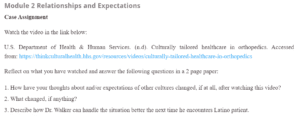Module 2 Relationships and Expectations
How have your thoughts about and/or expectations of other cultures changed, if at all, after watching this video?
I have learned not to generalize patients. I was not aware that Latino patients have a lower tolerance for pain. Patients can have the same surgical procedure, but the recovery process may be different because of their cultural background. That said, I will need to be more conversant with the cultural and religious expectations and try as much as I possibly can to respect patients along these lines.
What changed, if anything?
Making assumptions, as I have mentioned, is one thing I will no longer do. In this case, the patient was genuinely in pain, but the physician misjudged him. The other thing that I will do more often is to brainstorm with other staff and, more specifically, with team members. In this case scenario, had the physician brainstormed with his team members earlier, the information on pain tolerance would have long been discussed, and the patient would have gotten appropriate and timely help sooner rather than later.
Describe how Dr. Walker can handle the situation better the next time he encounters a Latino patient.
Every person experiences acute pain at one time in their life, and close to 100 million people in the US experience pain. Racial and ethnic minorities report experiencing more pain and also have a higher pain condition prevalence in comparison to non-Hispanic Whites. These differences based on ethnic and cultural grounds could be because of the differences in cultural factors, pain coping strategies, and pain processing. Furthermore, although pain makes up for 80 percent of all physician visits, many patients and, more so, ethnic minorities access inadequate management for non-malignant pain. Additionally, depression often occurs with chronic pain and may lead to worse patient outcomes and more functional impairment. Further, traditional Hispanic cultures hold that illness and pain are perceived as disharmony or punishment from God. Pain is discussed as a loss of connectedness at the spiritual level or a conflict with God, and at the same time, God is seen as the one who offers relief from pain (Rippentrop, 2005). Hence, because coping with pain has a religious aspect, the physician should investigate the relationship between pain sensitivity and religious coping and the extent to which these beliefs impact the pain experience of Hispanic patients. Further, the physician should know that protective factors in chronic pain development include work satisfaction, mental health, and social support. These factors align with Hispanics’ cultural emphasis on work values and family and may have a significant role in protecting patients from developing chronic pain. Also, research has shown that when chronic pain runs in the family, children are likely to develop the same Thus, the physician should research the patient’s family history to determine if the patient has a genetic predisposition to pain.
Identify at least one thing an organization can do to improve cultural competence.
Among Hispanic patients, pain is considered a cold disease that can be treated with hot foods and medications. Therefore, healthcare providers should consider this information when administering treatment by asking patients whether they are willing to accept specific medication that will counter this belief (Campbell et al., 2009). In line with this, some Hispanics believe that pain can be overcome without using medications and that the only time that medication should be used in absolutely necessary conditions, such as when the pain is too much as to interfere with a person’s ability to work or perform social roles (Monsivais & Engebretson, J. C. 2012). Hence, the organization should have a policy requiring pain assessment levels for Hispanics to be measured separately from other races and also to be aware that when a Hispanic reports at the physician’s clinic, they may very well be in unbearable pain and treat it as such.
References
Campbell, L. C., Andrews, N., Scipio, C., Flores, B., Feliu, M. H., & Keefe, F. J. (2009). Pain coping in Latino populations. The Journal of Pain, 10(10), 1012-1019.
Monsivais, D. B., & Engebretson, J. C. (2012). “I’m Just Not That Sick” Pain Medication and Identity in Mexican American Women With Chronic Pain. Journal of Holistic Nursing, 30(3), 188-194.
Rippentrop, A. E. (2005). A Review of the Role of Religion and Spirituality in Chronic Pain Populations. Rehabilitation Psychology, 50(3), 278.
ORDER A PLAGIARISM-FREE PAPER HERE
We’ll write everything from scratch
Question 
Module 2 Relationships and Expectations
Case Assignment
Watch the video in the link below:

Module 2 Relationships and Expectations
U.S. Department of Health & Human Services. (n.d). Culturally tailored healthcare in orthopedics. Accessed from: https://
Reflect on what you have watched and answer the following questions in a 2 page paper:
- How have your thoughts about and/or expectations of other cultures changed, if at all, after watching this video?
- What changed, if anything?
- Describe how Dr. Walker can handle the situation better the next time he encounters Latino patient.
- Identify at least one thing an organization can do to improve cultural competence.
Understanding Cultural Diversity in Healthcare. (2019). Case studies. Retrieved from https://www.ggalanti.org/
